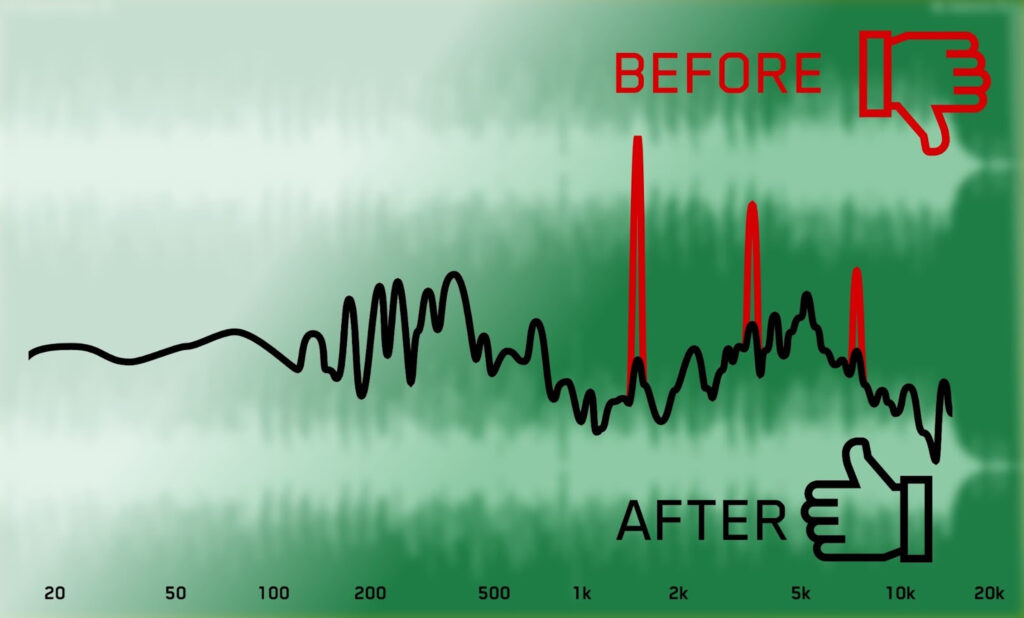Removing resonances during mastering depends on the specific track and the type of resonance. In some cases, it can improve the sound quality.
Mastering is an essential process in music production, where the final mix is optimized to sound professional and polished. One of the key elements of mastering is identifying and removing resonances in the mix. Resonances are frequencies that resonate or amplify in a particular space, creating an unpleasant and boomy sound.
However, removing resonances is not always necessary or beneficial. It ultimately depends on the individual track and the type of resonance present. We will explore the pros and cons of removing resonances in mastering and provide some tips for achieving a balanced and cohesive final mix.

Credit: flypaper.soundfly.com
Common Techniques For Removing Resonances
Removing resonances can be a useful technique during mastering. Common methods include using a parametric equalizer or a dynamic equalizer, but it is important to use these tools with care to avoid negatively impacting the overall mix.
If you’re into audio mastering, you know that resonances can be a pain to deal with. They can make your mix sound off-key or create unwanted frequencies that can ruin the overall sound. That’s why it’s important to know how to remove them. Here are three common techniques that you can use to remove resonances in mastering.
Dynamic Eq
Dynamic EQ is an effective technique to remove resonances. It works by using an EQ that can detect when a frequency is too loud and automatically lowers it. This ensures that the resonance is reduced without affecting the rest of the mix. Dynamic EQ can also boost frequencies automatically, so you can create a smoother, more balanced mix.
Multiband Compression
Multiband compression is another technique that you can use to remove resonances. It works by compressing only certain frequency ranges. By compressing just the frequency ranges that are causing the resonances, you can reduce the unwanted frequencies without affecting the rest of the mix. This technique is particularly useful for eliminating resonance from drum tracks.
Notch Filters
Notch filters are one of the simplest and most effective ways to remove resonances. They work by selectively removing a small band of frequencies from the mix, which can help to reduce resonances. Notch filters can be used to surgically remove unwanted frequencies without affecting the rest of the mix. This makes them a popular choice for mastering engineers. In conclusion, removing resonances in mastering is essential to creating a polished and professional-sounding mix. There are several techniques that you can use, including dynamic EQ, multiband compression, and notch filters. Try experimenting with each of these techniques to see which works best for you and your mix.

Credit: www.masteringthemix.com
How To Identify Problematic Resonances
Identifying problematic resonances in mastering is crucial for achieving a balanced sound. However, removing resonances should only be done if they are negatively impacting the overall mix. It is important to use a critical ear and understand when to address them or when to leave them as part of the natural sound.
Spectral Analysis
To remove resonances effectively requires identifying the problematic frequencies first. Spectral Analysis is one of the best ways to identify these problematic resonances. Spectral analysis is a graphical representation of the frequency spectrum of sound. During mastering, a spectral analysis tool can be used to identify peaks and dips in the frequency response of a mix. These peaks and dips can help locate the resonances that need to be addressed.
Listening Tests
Another way to identify problematic resonances is through listening tests. Although it is always recommended to use spectral analysis, listening tests are equally important, particularly to identify those resonances that do not appear in the frequency analysis. Listening tests involve the creation of an A/B comparison that helps in recognizing the rangy parts and the unbalanced regions of the audio mix.
Conclusion
Identifying problematic resonances accurately is highly important in mastering to ensure that the final mix sounds polished and professional. Spectral analysis and listening tests are the most recommended approach for identifying resonances that require correction. Combining these two methods will result in a better outcome for your tracks, but note that overdoing it may lead to an over-corrected mix that may sound unnatural and unconventional.

Credit: flypaper.soundfly.com
Frequently Asked Questions Of Should You Remove Resonances During Mastering
Where Resonance Should Be Avoided?
Resonance should be avoided in structures where vibration can cause damage or unwanted noise. This includes bridges, buildings, and machines. Resonance can also have negative effects on musical instruments and sound systems. It is important to understand and control resonance in order to prevent damage and maintain efficiency.
Why Resonance Is Avoided?
Resonance is avoided because it causes unwanted vibrations that can be harmful to structures or machinery. If left unchecked, resonance can lead to mechanical failure or damage over time. Avoiding resonance is important in maintaining the durability and longevity of equipment and structures.
What Frequencies To Cut When Mastering?
In mastering, there are no specific frequencies that must be cut. Rather, it depends on the specific mix and what needs to be addressed. However, some common areas to cut include low-end rumble, harsh highs, and muddy or resonant frequencies.
It’s important to use EQ sparingly and selectively, as cutting too much can negatively impact the overall sound.
How Do You Get Rid Of Resonant Frequency?
Resonant frequency can be eliminated by dampening vibrations and using vibration-absorbing materials. This can be done through the use of shock mounts, rubber feet, and acoustic foam. The goal is to reduce the vibration and prevent it from being amplified in resonance.
Conclusion
Removing resonances during mastering can result in a cleaner and more balanced sound. However, it’s important to keep in mind that not all resonances are bad and can add character to the mix. It’s key to make informed decisions based on the specific needs of the track and the desires of the artist.
With careful consideration and a trained ear, it’s possible to achieve a polished final product without sacrificing the unique qualities that make each track special. Ultimately, it’s up to the engineer to use their judgment and expertise to find the right balance between removing resonances and preserving the integrity of the mix.